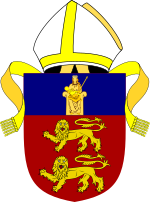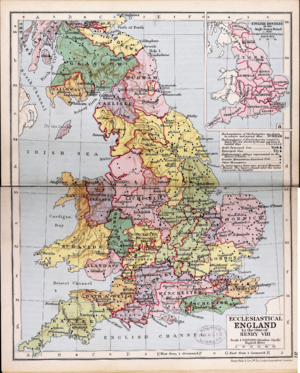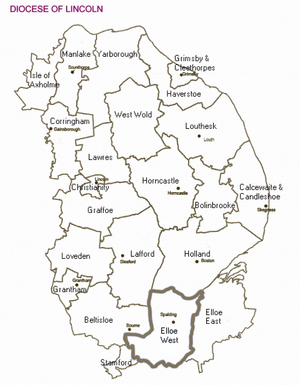Diocese of Lincoln facts for kids
Quick facts for kids Diocese of LincolnDioecesis Lincolniensis |
|
|---|---|

Coat of arms
|
|

Flag
|
|
| Location | |
| Ecclesiastical province | Canterbury |
| Archdeaconries | Lincoln, Stow and Lindsey, Boston |
| Statistics | |
| Parishes | 515 |
| Churches | 640 |
| Information | |
| Cathedral | Lincoln Cathedral |
| Language | English |
| Current leadership | |
| Bishop | Stephen Conway, Bishop of Lincoln |
| Suffragans | David Court, Bishop of Grimsby Nicholas Chamberlain, Bishop of Grantham |
| Archdeacons | Justine Allain Chapman, Archdeacon of Boston Gavin Kirk, Archdeacon of Lincoln Aly Buxton, Archdeacon of Stow and Lindsey |
| Website | |
| www.lincoln.anglican.org | |
The Diocese of Lincoln is a special church area in England. It is part of the Province of Canterbury, which is one of the two main church provinces in England. Today, the Diocese of Lincoln covers the whole county of Lincolnshire.
History of the Diocese
The Diocese of Lincoln has a very long history. It can be traced back to the Diocese of Leicester, which was founded in 679 AD. That's over 1,300 years ago!
The main office, or "see," of the church area moved a few times. First, it moved from Leicester to Dorchester in the late 800s. Later, it included the area of the Diocese of Lindsey and moved to Lincoln.
At one point, the Diocese of Lincoln was the biggest church area in England. It stretched all the way from the River Thames in the south to the Humber Estuary in the north. In 1072, a bishop named Remigius de Fécamp moved the main office to Lincoln.
Over time, the diocese became smaller. In 1541, two new dioceses, Oxford and Peterborough, were created from parts of the Lincoln diocese. This left Lincoln with two separate pieces of land, one in the north and one in the south.
More changes happened in 1837. The southern parts of the diocese were moved to other church areas. For example, Bedfordshire and Huntingdonshire went to the Diocese of Ely. Hertfordshire went to the Diocese of Rochester, and Buckinghamshire joined the Diocese of Oxford. Also, the county of Leicestershire moved from Lincoln to Peterborough. Later, in 1927, Leicestershire became its own independent church area, the Diocese of Leicester.
In 1884, another part of the diocese, called the Archdeaconry of Nottingham, was separated. It became part of the new Diocese of Southwell.
How the Diocese is Organized
Bishops
The main leader of the Diocese of Lincoln is the Bishop of Lincoln. There are also two other bishops who help him. They are called "suffragan bishops." These are the Bishop of Grimsby and the Bishop of Grantham. They help with church work in different parts of the diocese.
Sometimes, there are also retired bishops who live in the area. They can help out as "honorary assistant bishops" when needed.
Archdeaconries
The Diocese of Lincoln is divided into three main areas called "archdeaconries." These are then split into smaller areas called "deaneries."
The three archdeaconries are:
- Archdeaconry of Lincoln (started in the 11th century): This area includes deaneries like Bolingbroke, Calcewaithe and Candleshoe, Christianity, Graffoe, Horncastle, Lafford, and Louthesk.
- Archdeaconry of Stow and Lindsey (also started in the 11th century): This area covers places like Isle of Axholme, Corringham, Grimsby and Cleethorpes, Haverstoe, Lawres, Manlake, West Wold, and Yarborough.
- Archdeaconry of Boston (created in 2013): This newer area includes deaneries such as Aveland and Ness with Stamford, Beltisloe, Elloe East, Elloe West, Grantham, Holland, and Loveden.
The diocese also has its own newspaper, called Crosslincs, which comes out every two months.
See also
- Bishops of Lincoln
- Suffragan Bishop of Grimsby
- Lincoln Cathedral



